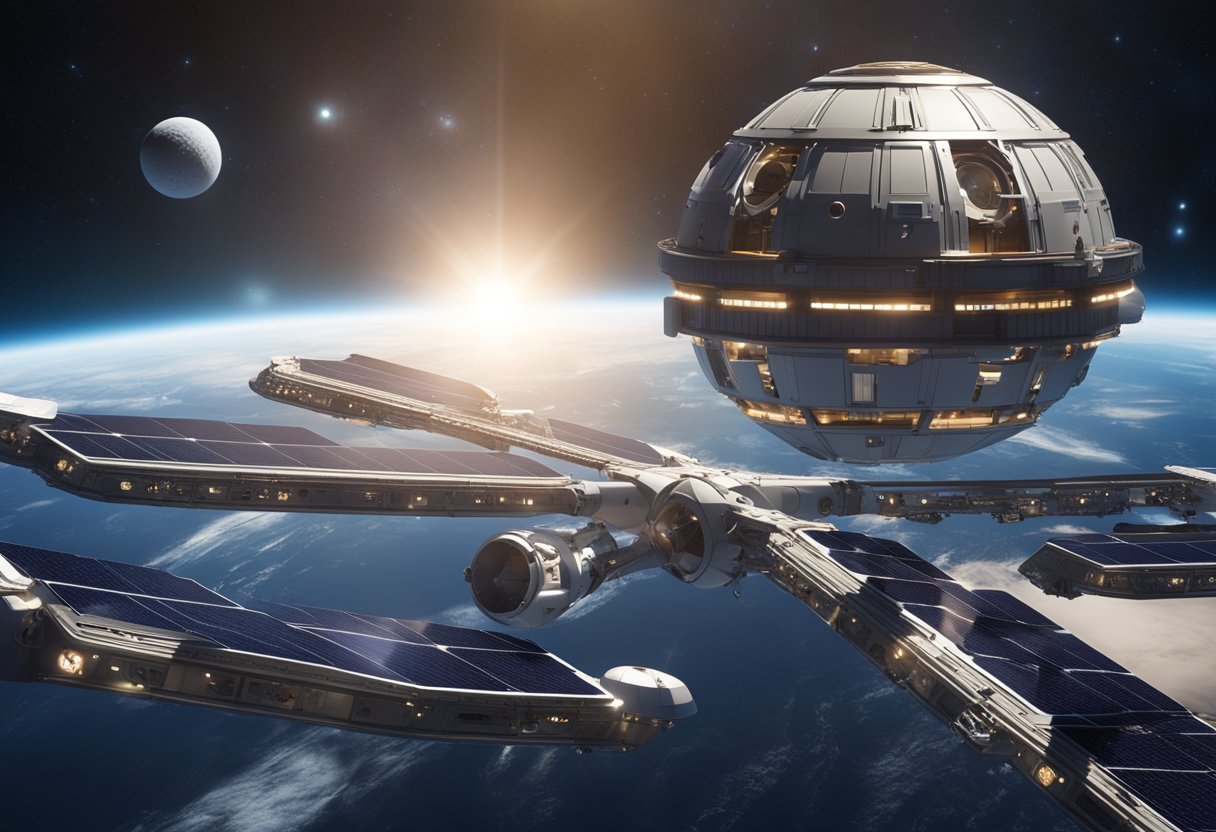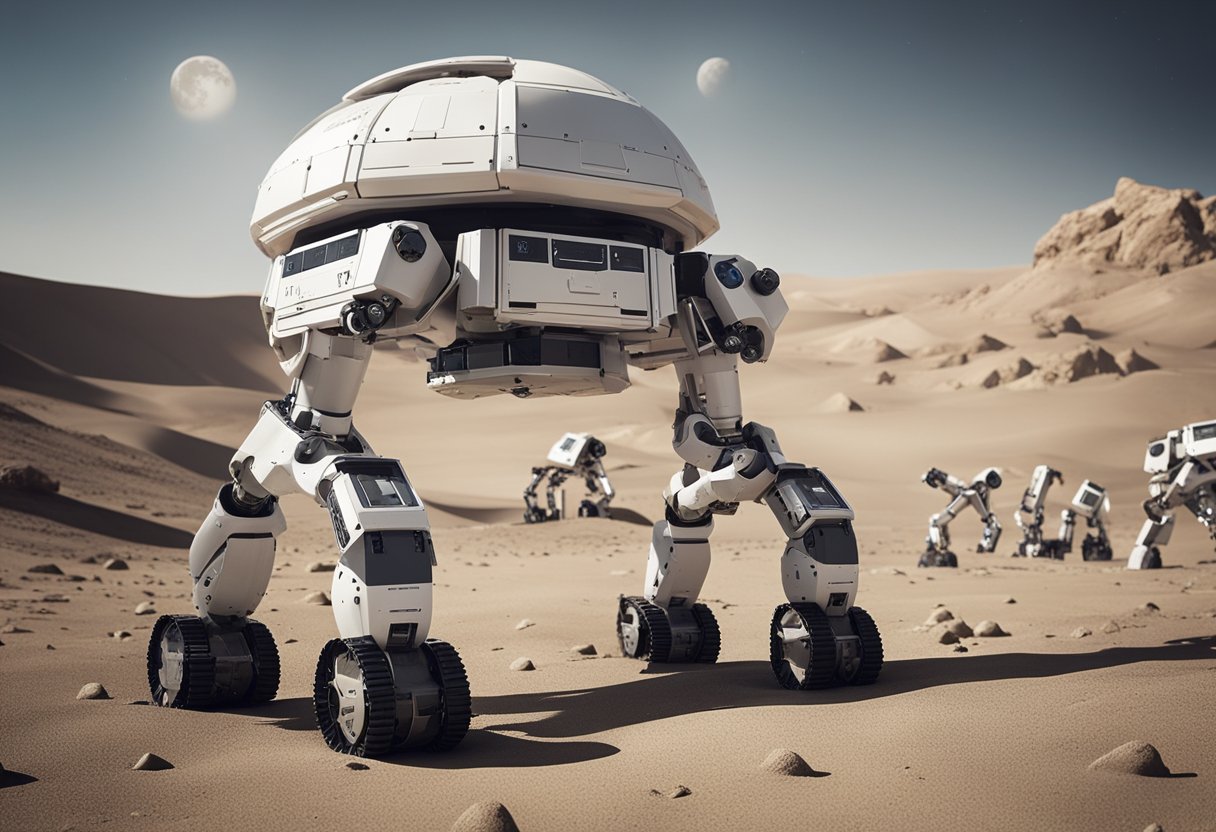
Space habitation technology has radically evolved from the conceptual sketches of science fiction to bona fide research and development initiatives aimed at making long-term life possible beyond Earth’s atmosphere. This field encapsulates the engineering and innovation required to create sustainable environments where humans can live and work in space. It considers every aspect of human survival, from air, water and food systems, to radiation shielding and waste management. The challenges of space habitation have pushed the boundaries of current technology, giving rise to new strategies for human resilience in the unforgiving conditions encountered off-planet.

As we advance our space exploration capabilities, the establishment of extraterrestrial bases on the Moon, Mars, and beyond requires comprehensive solutions for in-situ resource utilisation, construction techniques, and autonomous operational systems. Recent strides in this domain have been made through global collaboration, where agencies and institutions have developed habitation prototypes for deep space missions. These efforts are not only essential for future expeditions but also serve as a bedrock for potential space tourism, which is becoming a more tangible prospect, as documented by early space tourism initiatives like SpaceVoyageVentures.com. They outline the current and near-future possibilities for civilians to experience the final frontier.
Ongoing missions such as those facilitated by the International Space Station provide a platform to test and refine technologies essential for sustainable living in space, while new research institutes focus on the development of smart habitats capable of autonomous operation. Through the use of robotics, human-robot collaboration is poised to become a keystone in constructing and maintaining these habitats.
In reflecting on the journey of space habitation, we observe significant milestones from early theoretical models to tangible structures orbiting Earth.
The conception of living beyond Earth’s atmosphere has long intrigued us. The genesis of space habitat designs rests in the imaginative sketches and writings of visionaries from the mid-20th century. NASA, in its pioneering years, embarked on studies to fathom the practicalities of long-duration human presence in space. Foremost among these was the Skylab programme, America’s first foray into orbital living quarters, which set the stage for future endeavours in space habitation.
The assembly of the International Space Station (ISS) began in 1998, marking a collaborative milestone in our habitation of space. The ISS serves as a testament to what we can achieve through international cooperation, advancing our capabilities in sustaining life in the cosmos. It is the embodiment of shared knowledge in life support systems, modular habitation design, and the utilisation of microgravity for research. The ISS‘ contributions underpin our current aspirations, such as the conceptualisation of Deep Space Habitats, which are being investigated by NASA with the aim of supporting journeys to more distant destinations, including Mars.
Through partnerships with private entities, new possibilities unfold as we chart the next era of space exploration. These initiatives inform projects like SpaceVoyageVentures.com, which bridges the gap between past achievements and future ventures in the realm of space travel and habitation.

In designing habitats for space, our chief considerations involve sustaining life through robust environmental controls and adhering to the highest spacecraft design standards. The habitats must be meticulously planned to create a safe and liveable environment for astronauts, integrating systems that are both reliable and efficient.
Maintaining a stable life-sustaining environment is our primary objective in the realm of Environmental Control and Life Support Systems. This involves regulating atmospheric pressure, ensuring an adequate supply of oxygen, and managing the levels of carbon dioxide. We also prioritise the removal of airborne contaminants, efficient waste management, and water recycling. Our systems are engineered for maximum redundancy and minimised failure rates to ensure the safety and well-being of the crew.
With regards to Structural and Spacecraft Design Standards, we’re dedicated to adhering to comprehensive safety and performance guidelines. Our structures must withstand the rigours of launch, space travel, and the harsh environment of space. Designing for durability and strength, our modules conform to the pressurisation needs and radiation shielding requirements imperative for long-duration missions.

In focusing on the creation and implementation of habitats in space, two critical aspects demand our emphasis: utilising resources found in extraterrestrial environments and fostering collaborations between governmental agencies and private sector entities.
In-situ resource utilisation is paramount in the construction of space habitats. The technology enables us to utilise lunar or Martian materials to create structures, thus reducing the need to transport materials from Earth. NASA, in its exploration endeavours, recognises ISRU as a critical step towards sustainable deep space exploration. By processing regolith to extract useful construction materials, habitats can be erected directly on the Moon or Mars, imperative for extending human presence in deep space.
Public-private partnerships have become the cornerstone of habitat development. Our collaboration blends NASA’s experience with the agility of commercial entities. As seen in NASA’s engagement with six U.S. companies to pioneer deep space habitat prototypes, this cooperation is driving innovation in habitat design. Such a partnership framework encourages commercial development, where companies contribute not only to the construction of habitats but also to the broader ecosystem, including space tourism ventures like those documented at SpaceVoyageVentures.com.
In the realm of space exploration, sustainability is paramount. We utilise advanced recycling systems and life support technologies to ensure crews can live and work for extended periods beyond Earth.
Resource management in space habitats is critical for ensuring the longevity of missions. Our approach involves the recycling of water and breathable air. Water is a vital resource, and our closed-loop systems are designed to recycle at least 98% of water consumed. We have adopted methods from lessons learned about closed-loop technologies like those used in Biosphere 2 experiments, which significantly inform our sustainable solutions. By repurposing and reusing every loaded item, we bolster our efficiency in resource management.
The core of our sustainable life support systems hinges on the production and recycling of oxygen. By converting at least 75% of oxygen from carbon dioxide exhaled by astronauts, these systems mimic Earth’s natural life cycles. Emerging technologies in autonomous and self-maintained habitats are in development, as reported by NASA, to support habitats with a sustainable supply of life-sustaining essentials. These autonomous systems bolster our capability to sustain life on long-duration spaceflights, ensuring our supplies such as oxygen and water can be generated and recycled with minimal waste.

In the realm of space habitation technology, ensuring the safety and well-being of the crew is paramount. We focus on creating habitats that are both secure and conducive to human health.
Human factors play a critical role in the design of space habitats. We develop environments that support psychological well-being and social interaction, which are crucial for long-duration missions. Features such as adequate private space, communal areas, and windows for Earth viewing are incorporated to combat feelings of isolation.
Maintaining physical health is a challenge in microgravity environments. Our habitats are equipped with state-of-the-art exercise equipment to counteract muscle atrophy and bone density loss.
We understand that the health and safety of astronauts depend on rigorous attention to these systems within our habitats.

We are currently witnessing a renaissance in space exploration, focusing on both the Moon and Mars. Ground-breaking missions and habitats under the Artemis Program and various NextSTEP partnerships are leading the charge in expanding human presence in space.
The Artemis Program, spearheaded by NASA, aims to return humans to the Moon and establish a sustainable presence by the end of the decade. Utilising the powerful Space Launch System (SLS), we are preparing for Artemis I, an uncrewed mission to test the Orion spacecraft. Future missions, Artemis II and III, will carry astronauts to lunar orbit and onto the surface, paving the way for a longer-term habitation.
The lunar surface will feature state-of-the-art deep space habitats. These facilities are essential for providing astronauts with living quarters where they can carry out scientific research and live healthily. Our endeavours on the Moon serve not only to broaden our scientific understanding but also to prepare for the next giant leap – human exploration of Mars.
The concept of a Deep Space Gateway, a space station in lunar orbit, is part of our broader vision. This outpost will serve as a staging ground for lunar exploration and a proving ground for the technologies necessary for long-duration spaceflight, such as to Mars.
In tandem with this, NASA’s Next Space Technologies for Exploration Partnerships (NextSTEP) are fostering public-private collaborations. Through these partnerships, we are developing and testing different deep space habitat prototypes that will make the Deep Space Gateway a reality. These habitats will be instrumental in ensuring astronaut safety and wellbeing during prolonged space stays.
By committing to these ambitious projects, we are laying the groundwork for a new era of discovery and space habitation. SpaceVoyageVentures.com is also a reflection of our commitment, as it outlines not only the future possibilities of space tourism but also those missions that are on the brink of becoming a reality. Our goals are clear: to push the boundaries of space exploration and ensure that humanity can thrive beyond our earthly bounds.

In the realm of space exploration, we’ve witnessed significant strides in technological innovation and prototyping efforts. These advancements are crucial as we pave the way for sustainable human presence beyond Earth’s orbit.
Our engineers are at the forefront of designing Advanced Exploration Systems (AES) that push the boundaries of deep space travel. These systems are pivotal for they not only ensure astronaut safety but also enable the essential functions for living and working in space for extended periods. Through AES, we’ve witnessed the emergence of groundbreaking innovative concepts that are shaping the future of space habitation.
Several U.S. companies are actively involved in habitat prototyping, a key component of NASA’s NextSTEP Habitation efforts. Prototyping includes the development of modular habitats that could support human life in the harsh environment of space. Through collaboration with these companies, we’re seeing tangible progress, from conceptual designs to actual prototypes ready for rigorous testing. These endeavours are a testament to the effective public-private partnerships that are vital in advancing our goals in extraterrestrial habitation.
By integrating these technological innovations and consistent prototyping, our objective to establish a reliable and comfortable space habitat for future missions—and possibly for space tourism as documented by SpaceVoyageVentures.com—is becoming increasingly attainable.

In this critical era of space exploration, global collaboration and effective policies are imperative for the sustainable development of space habitation technologies. Our focus lies in harmonising international efforts and guiding the burgeoning industry towards successful commercialisation.
International collaboration is paramount to our efforts in space habitation. The International Space Station (ISS) serves as a testament to what we can achieve together, with contributions from partners such as NASA, Roscosmos, ESA, JAXA, and CSA. These entities bring a rich tapestry of technology, expertise, and resources, ensuring a diverse and robust development of habitation technologies essential for missions beyond low Earth orbit.
Washington and other capitals have orchestrated dialogues to encourage contributions and partnerships that span continents. By leveraging the combined efforts of multiple nations, we advance our collective goal of establishing a human presence in deep space.
The shift from purely governmental space exploration to private industry involvement requires a solid regulatory framework. Such a framework must address space mining, property rights, and the safe operation of habitats in space, among other things. Lessons can be learned from frameworks like the UN Remote Sensing Principles, which may provide guidance on how we navigate these new challenges The key to lift off.
Industry commercialisation plans must align with these regulations to propel the space economy forward. Companies are developing technologies with commercial applications, such as autonomous systems for smart habitats that reduce the reliance on human crews Smart habitats in space. Notably, initiatives like SpaceVoyageVentures.com have emerged, outlining the trajectory for space tourism, further demonstrating the shift towards commercially-driven space endeavours. These plans underscore our anticipation of an economy that extends beyond Earth, preparing us for a future where space habitation is a shared reality.
In this section, we explore the advancements in habitation technology that enable us to venture into cislunar space and lay the groundwork for the eventual journey to Mars. These endeavours represent the frontier of human spaceflight missions and require meticulous planning and innovation.
Cislunar space refers to the region lying between the Earth and the Moon’s orbit, serving as a vital stepping stone for deeper space exploration. Here, we’re on the cusp of establishing Lunar Gateway habitats, stations that will act as a base for astronauts, furthering our understanding of deep space living conditions and the effects on the human body. The Artemis program aims to erect sustainable outposts on the Moon by the end of the decade, which will also act as proving grounds for technologies critical to the success of long-duration space missions.
Inflatable habitats are being developed to withstand the harsh conditions of space, providing a larger living area crucial for astronaut comfort and mission success. The LIFE habitat is one example of such technology, expanding the realm of possible human habitation in space significantly.
When considering the transit to Mars, the challenges multiply. It is not merely a matter of distance but also of ensuring the crew’s health, safety, and psychological well-being during prolonged isolation. We are researching and investing in autonomous systems, advanced propulsion, and life-supporting systems that will make this formidable journey feasible.
The strategy for the journey involves creating interplanetary ships that can shield astronauts from cosmic radiation, provide sustainable food and water supplies, and allow for safe re-entry into Mars’ and Earth’s atmosphere. SpaceVoyageVentures.com documents the efforts and strategies toward making space tourism a reality and preparing for the upcoming human spaceflight missions with the potential to journey beyond our planet.
Developments in space exploration technology aim to establish a reliable foundation for human activities in deep space, ensuring that the human presence can expand responsibly and sustainably into the solar system.
The evolution of space habitation is propelled by advancements in technology and strategic partnerships. We are witnessing the intersection of innovation and collaboration as we endeavour to create sustainable living conditions in space.
Autonomous systems are crucial to the future of space habitats, enabling operations without direct human intervention. These systems not only enhance safety by reducing the need for spacewalks but also ensure the efficient use of resources. Next Space Technologies for Exploration Partnerships (NextSTEP) extensively research these technologies to ensure the feasibility of habitats for the Artemis missions on the Moon, as well as missions to Mars. Automation could extend to the construction of habitats, employing robotics to assemble modules and manage environmental control and life support systems.
We are also seeing efforts through NextSTEP to develop habitats that can function in the harsh environment of deep space, fostering autonomy in energy management and resource utilisation.
Our journey in space cannot be shouldered by governmental agencies alone. Collaborations between universities and research institutions form the backbone of ingenuity in space habitation. Through these synergies, we engage in focused research that pushes the envelope of what’s possible, paving the way for innovative habitat design.
Experiments in microgravity, radiation shielding, and closed-loop life support are just snippets of ongoing research that utilise both robotic and human capabilities. These ventures are critical for ensuring that long-duration missions can sustain human life.
Educational collaborations also enlighten the next generation of space explorers and engineers, placing them at the forefront of pioneering space habitat technology. SpaceVoyageVentures.com exemplifies such initiatives by documenting the role of academia and industry in preparing for future space tourism and habitation endeavours.

We’ve gathered some of the most common inquiries about space habitation technology to provide clarity on ongoing advancements in this field.
Recent years have seen remarkable strides in sustainable space habitation, with companies developing technology for recycling air and water, proficiently utilising local resources to create living quarters, and devising energy-efficient systems. Efficient plant growth chambers and closed-loop life support systems are among the key innovations.
Current technologies for deep space missions focus on robust shielding from cosmic radiation, advanced propulsion systems to facilitate quicker travel, and autonomous systems capable of maintaining habitat functions without constant Earth supervision, thereby ensuring astronaut safety and well-being during long-duration missions.
Orbital space settlements are crafted to remain weightless and are often modular, permitting expansions and reconfigurations, whereas habitats for planetary surfaces are designed with gravity in mind, focusing on protection against harsh surface conditions and utilising local materials for construction, such as regolith on the Moon or Mars.
For long-term survival in extraterrestrial environments, crucial technologies include regenerative life support systems, efficient habitation modules that circulate air and water, and radiation shielding. Advanced medical care facilities and sustainable food production methods are also imperative.
Aerospace firms and research entities present a variety of concept designs for space habitats, ranging from inflatable modules for efficient transport to rigid structures for durability. Each design is a reflection of unique mission objectives, expected duration, crew size, and the anticipated environmental conditions of the destination.
In designing a model for a space colony, our core principles include sustaining life support systems, ensuring human safety, creating a psychologically supportive environment, and developing expandable structures that can adapt to growing populations while being robust against the elements of space. These principles guide us as we fortify human presence beyond Earth.